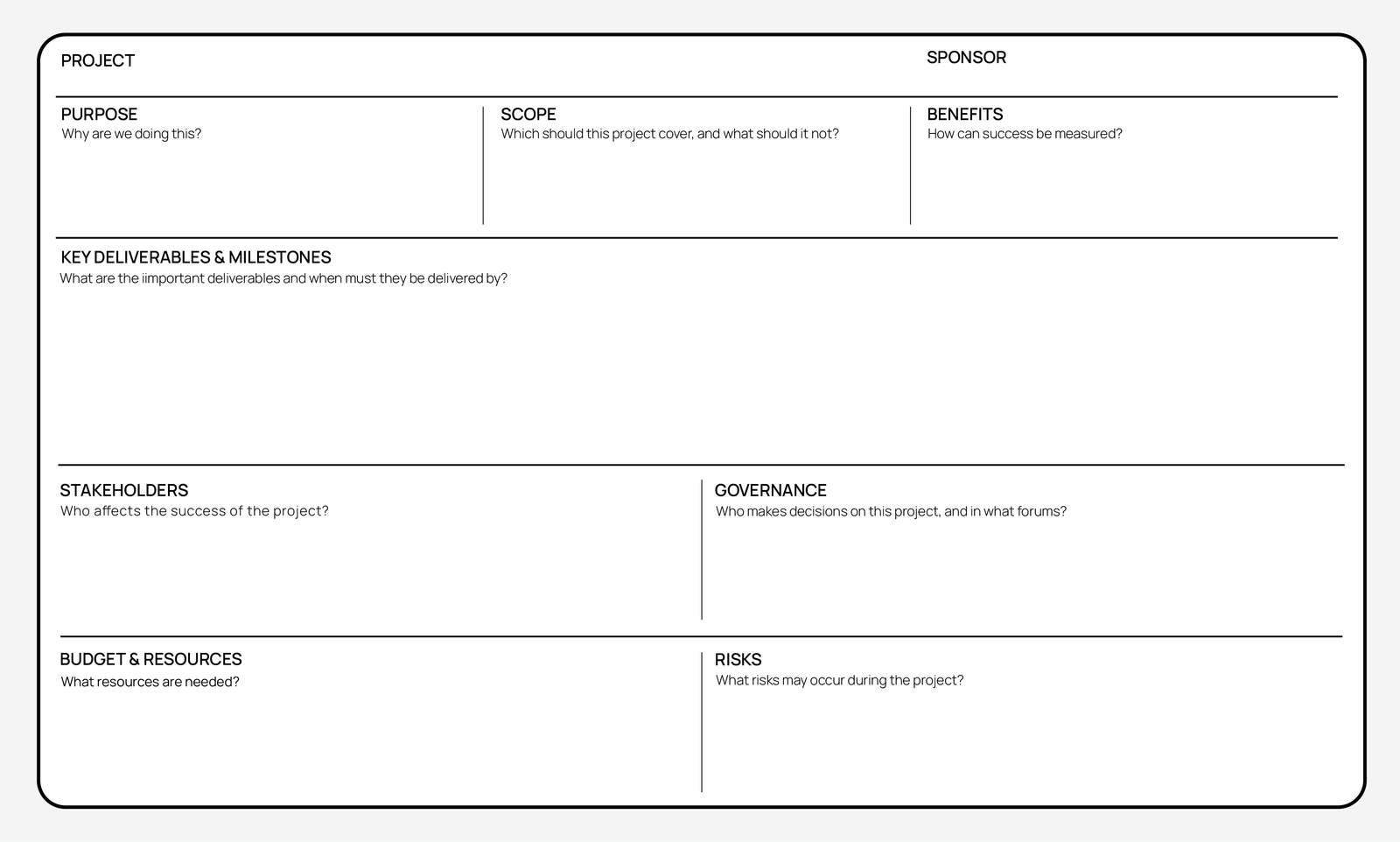Project Initiation Document (PID)
The Project Initiation Document (PID) is a tool used during the commissioning of projects. It acts as a formal agreement and handover document between the project sponsor (the person funding and authorising the project) and the project manager (responsible for delivery).
The PID provides a shared understanding of the project’s objectives, scope, deliverables and resources. It serves as both a planning and reference document, ensuring that all stakeholders are aligned from the outset and that the project manager has the authority and clarity needed to move forward.
The PID typically includes the following key elements:
Sponsor: The person or group funding and championing the project
Purpose: The project’s key objective/s and why they’re important
Scope: What the project will include and exclude
Benefits: The value expected to be created by delivering the project
Key deliverables and milestones: Important deliverables and when they must be delivered by
Stakeholders: Individuals or groups involved in or impacted by the project
Governance: Decision-making processes and approval structures.
Budget and resources: The financial and human resources required
Risks: Potential challenges
The results
A clear, concise 1-page document that outlines key project information, including objectives, scope, deliverables, benefits.

When to use it
Work Commissioning: When initiating a new project or initiative
Stakeholder Alignment: When aligning and clarifying expectations among all stakeholders involved in the project or initiative
Project Planning: As a reference document when developing a more detailed project plan
Strengths
Simple
Visual and easy to understand
Weaknesses
Can lack detail
Misinterpretation risks if unclear
Can be heavily assumption based
How to use it?
What do I need to start?
A clear understanding of the motivations or challenges that led to the project’s initiation.
How to use it?
Who to involve?
Drafting the Project Initiation Document can be done alone, but it should involve engaging:
- The person sponsoring the project
- The person responsible for delivering the project
- People who have a key stake in the project’s success
Step by step
1
Define the project purpose
Outline why the project exists and what it aims to achieve. Cleary state how the project aligns with the organisation’s broader goals or strategies. Ask questions like:
- What problem is the project addressing?
- Why is this project important?
- How does this project contribute to organisational objectives?
2
Clarify the project scope
Clearly define what the project will cover and what it will not. Ask questions like:
- What are the key activities the project will include?
- What is explicitly outside the project’s scope?
- What limitations or constraints might impact the project?
3
Outline benefits
Clearly state the expected benefits of the project. There should be both tangible and intangible benefits, which align with the organisation’s objectives. Ask questions like:
- What are the expected benefits of the project?
- How will these benefits impact the organisation?
- How can these benefits be measured?
Consider using a Benefits Map.
4
Define key deliverables and milestones
Identify the deliverables that are important to achieving the expected project benefits. Determine if there are any critical deadlines by which these deliverables need to be completed to ensure project success. Ask questions like:
- What deliverables are necessary to achieve the project’s expected benefits?
- How do these deliverables contribute to the overall project goals?
- When should each deliverable be completed to ensure timely progress?
5
Identify key stakeholders
List the people or groups who will be involved in or affected by the project. Determine their roles, levels of influence, and how they should be engaged. Ask questions like:
- Who will be impacted by this project?
- Who needs to be involved for the project to succeed?
- How should stakeholders be kept informed throughout the project?
Consider using a Stakeholder map.
6
Establish governance and roles
Define the project’s governance structure, including reporting lines, decision-making processes, and communication channels. Ask questions like:
- Who is responsible for approving major decisions?
- What is the communication plan for updates and progress?
- What is the escalation process for issues?
7
Outline budget and resources
Estimate the financial resources and human resources required to complete the project. Consider any tools, equipment, or external support needed. Ask questions like:
- What budget is needed to achieve the project’s goals?
- What resources (people, tools, materials) will be required?
- Are there any potential resource constraints?
8
Identify risks and mitigation strategies
Conduct a risk assessment to identify potential challenges or issues that could affect the project. Develop mitigation strategies to address these risks. Ask questions like:
- What risks could impact the project’s success?
- How likely are these risks to occur?
- What can be done to mitigate these risks?
Highlight important risks on the initiation document **
Consider using Risk Mapping.
9
Obtain approvals and feedback
Once the draft PID is complete, present it to key stakeholders for feedback and approval. Incorporate their input to ensure alignment and clarity before finalising the document. Ask questions like:
- Does the PID cover all necessary details for the project to move forward?
- Have all stakeholders provided feedback and approval?
- Are there any unresolved concerns or questions?